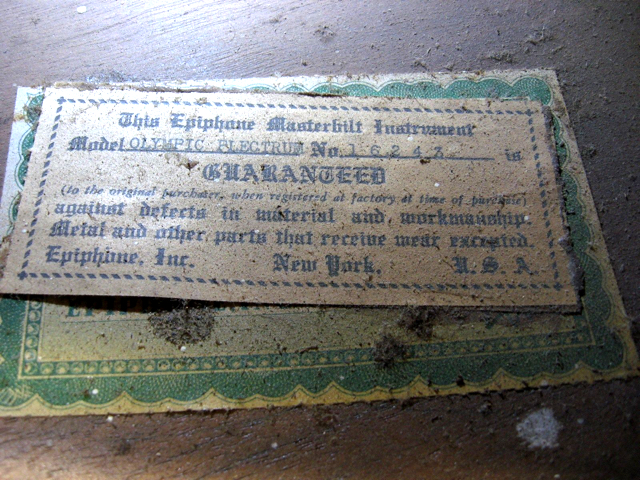
Close-up #50: Labels and serial numbers,
part 2 – anachronisms and oddities
In part 1 of our text about the internal labels found in Epiphone instruments between 1931 and 1956, we described the chronology of their standard use in new instruments as they left the factory. In this second part we describe some of the confusing exceptions, anachronisms and oddities that have shown up – and we also present our theories to explain these "phenomena".
Let's look at the anachronisms first: These are examples which show a chronological "mismatch" between the label style and the serial number: As discussed in part 1, each label style is associated with a certain production period/SN range when those labels were typically used in new guitars leaving the factory. The examples we present and discuss here are cases such as:
- instruments with a relatively low SN which is present on a much "later" label style that was not yet introduced when the instrument was manufactured;
- instruments with a "later" SN present on an "earlier" label style that was typically already out of use when the instrument was made.
As we will see in our examples, there is one common detail which seems to be a key to understand these mysteries: The "Masterbilt" labels, "green" labels and "blue" labels in all these unusual cases bear a typed SN – NOT the standard pre-printed SN as described in part 1.
The picture below shows the difference between the two serial number styles on a "Masterbilt" label: large pre-printed SN (top) and typed SN (bottom).

While new Epiphone instruments typically had labels with pre-printed
SNs, the "blank" labels with typed SN were obviously put into some
older Epiphone guitars – with the original SN (and model) typed in.
But why and at what occasion would this make sense?
Unfortunately, no official information regarding this matter is known today. So all we can do to find an answer is to study the facts and use our imagination ...
Our theory: When an instrument came back to the Epiphone factory for a repair, it was a common practice to glue in a new "blank" label of the current style – with the original SN inserted by typewriter.
If this scenario is feasible, "anachronistic" labels would indicate that the instrument underwent a repair or refurbish at the factory. Let's keep this in mind when looking at the examples below.
1. Label style "later" than date of typed SN
Example 1a: "Masterbilt" label with typed SN of 1931 (="oval" label period, stamped SN still present)
DeLuxe SN 5049 is a great example: The SN indicates that this is a very early Masterbilt guitar, made in 1931. The original blind stamped SN is visible – but there is also a "Masterbilt" label with the original SN typed into the blank number field!
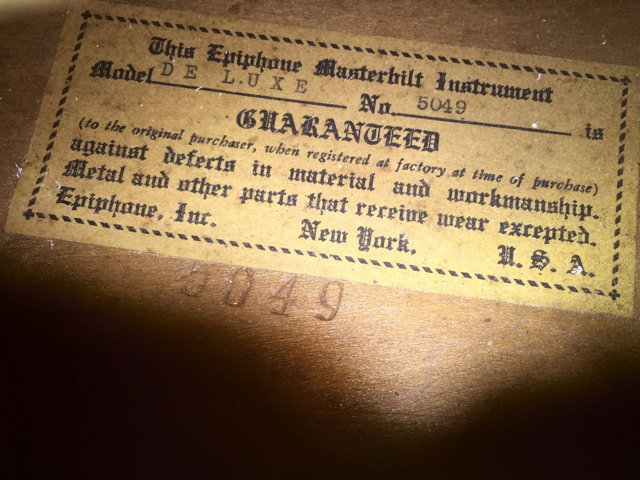
Our theory suggests that this 1931 DeLuxe went back to the factory for repair/refurbish – which must have been after the "Masterbilt" label was introduced, i.e. 1936 or later. And there are indeed signs for such work: Note that this 1931 DeLuxe today has a top with the "cello" f-hole shape of the post-1934 era and a blonde finish (instead of the original segmented f-holes and sunburst) – well possible that the guitar received the new label when this work was done.
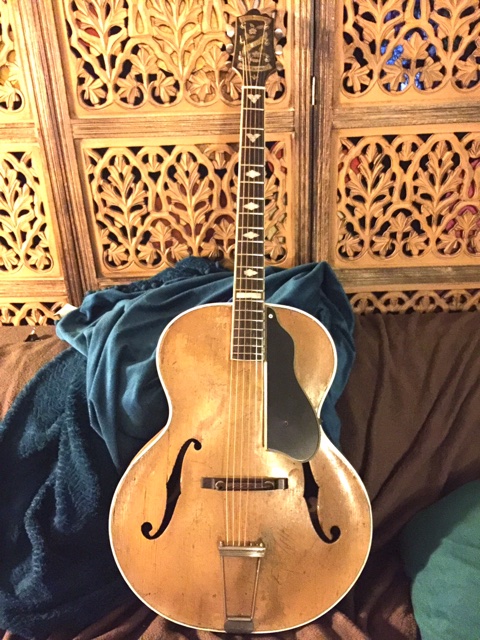
Example 1b: "Blue" label with typed SN of 1934 (="Long Island" label period)
Triumph SN 8215 has a "blue" label with typed SN which is from a number range when the "Long Island" label was used in new guitars. Since the "blue" label was not introduced before 1943, we guess this guitar received it during a repair visit at the Epiphone factory during or after WW2.
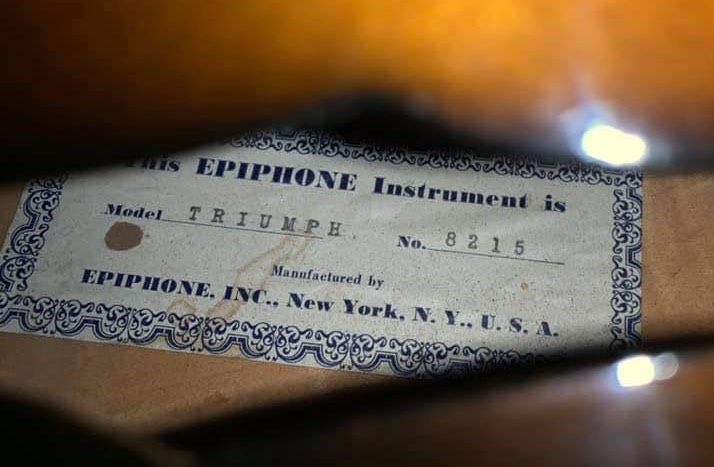
Are there any apparent signs of later factory work? As previous owners have confirmed, this 1934 Triumph guitar shows an older refinish, and interestingly has a newer Epiphone bridge in the typical mid-1940s style with large thumbwheels – and the original SN "8215" stamped into the bridge foot! (See Close-up #44 for more info about Epiphone bridges.) Our guess is that the newer bridge and label were both fitted at the same occasion in the mid-1940s.
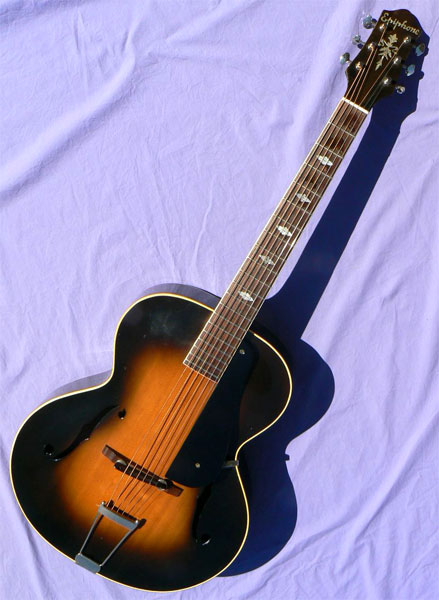
Example 1c: "Blue" label with typed SN of 1937 (="Masterbilt" label period)
Triumph SN 12302 was manufactured in 1937, and the f-hole shape and placement are correct for that year. However the neck/headstock is obviously from a much later period: That inlay style was not in use before 1948, and the truss rod location at the neck may even hint to the 1950s. We guess that the later "blue" label with the original SN typed was added when the guitar received the new neck – replacing the "Masterbilt" label that originally must have been there.
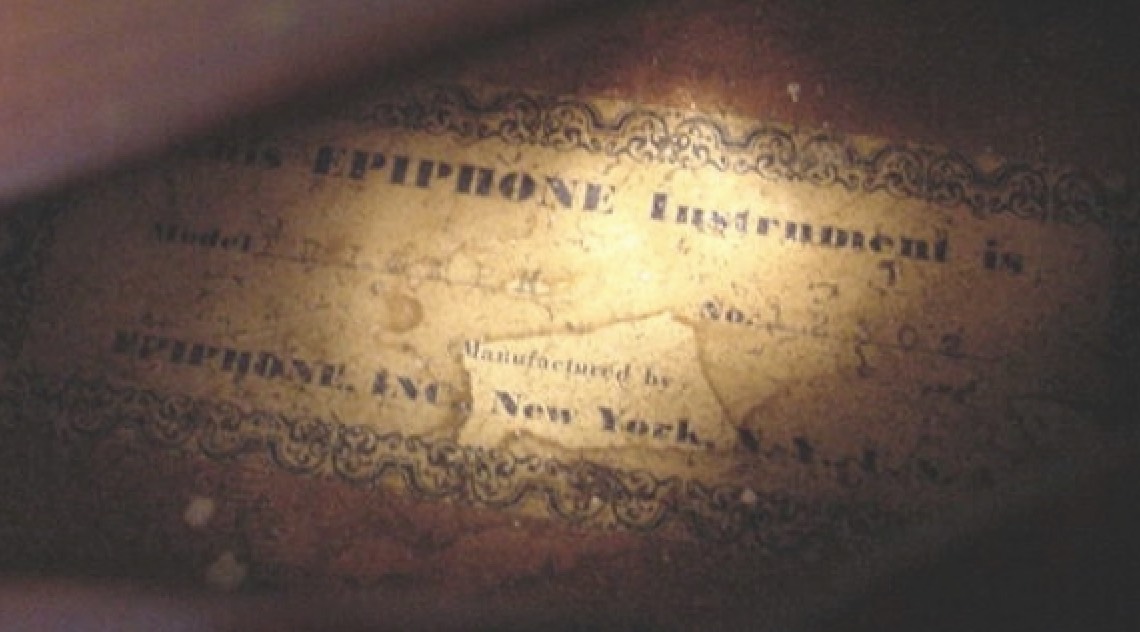
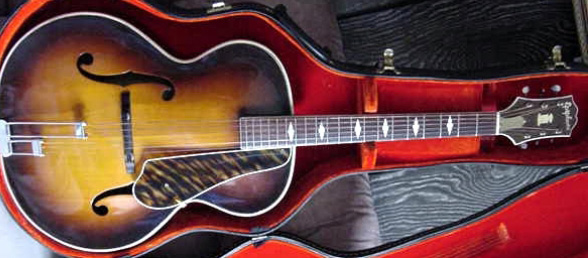
2. Label style matches date of SN which
is typed (not printed)
There are also cases of typed SNs on labels from the 1936–56 period that are actually the "correct" style for the number's year. We believe this indicates that the original label with pre-printed SN was either replaced during a later repair – or that for some unknown reason it may not have been put into the new instrument.
Triumph SN 55167 appears to be a repair case: While the neck with headstock inlay is correct for a 1946 serial number, the top with its modern-shape f-holes doesn't – it looks 1949 or later, so probably a replacement. A new "blue" label with typed SN was likely fitted during this repair.

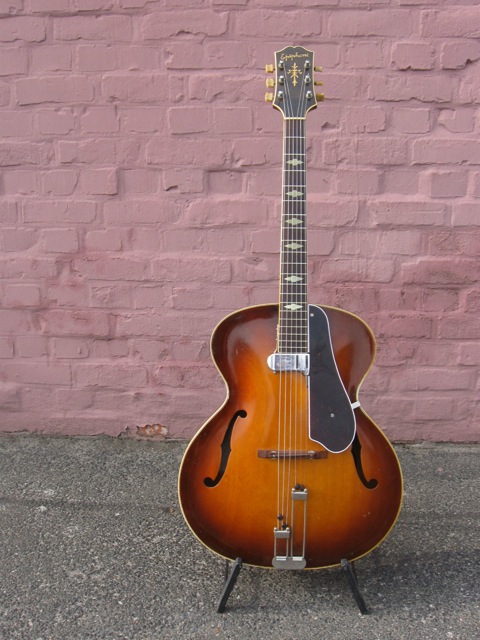
However we can't rule out that some instruments with a typed SN on a
"period correct" label may actually have left the factory like this
when new. Although this is speculation: We can imagine that in some
cases the unique original label with printed SN got damaged or lost –
either during printing or when gluing into the body – and needed to be
substituted by a label with typed SN.
An interesting case in this context: We noticed that most c. 1950 instruments with a SN in the very low 60000s range seem to bear a "blue" label with typed SN – see pictures of SN 60028 in example 4a further below. Why that?
Our guess here: Epiphone ran out of the pre-printed labels which had only been produced up to SN 59999; they needed to order a new run of labels with SNs above 60000, but it looks like these had not been delivered yet when the first 60000s instruments were ready to ship – so they had to use some left-over blank labels and hand-type the SN. We believe the following detail supports this scenario: When closely comparing pre-60000 and post-60000 labels (see photos below), there is a slight difference in the position of the printed SN – obviously a sign of two different print runs!
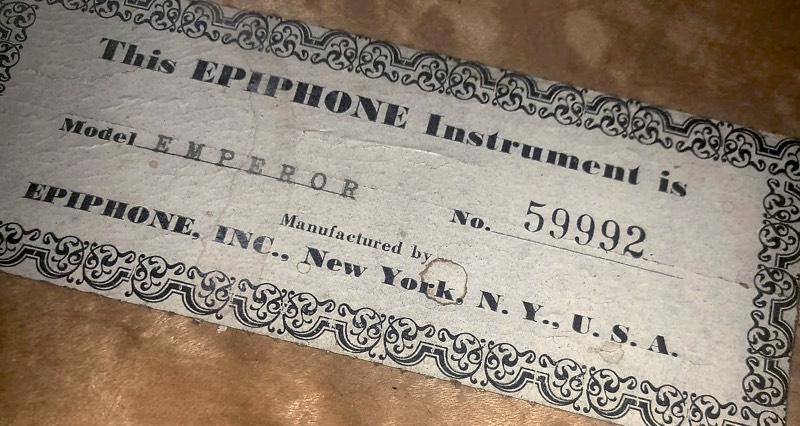
Pre-60000 label (above): Note the space between the printed number and the line.
Post-60000 label (below): Note that the number is now printed precisely on the line.
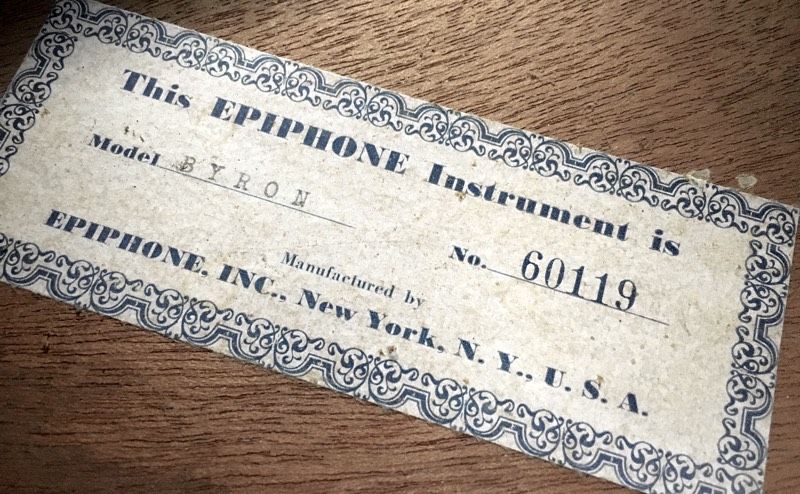
3. Label style "earlier" than date of typed SN
Among Epiphone instruments with serial numbers from 1939 to 1943 – the period of the "green" label – we have come across some examples bearing a "Masterbilt" label with typed SN – a label style which generally had been discontinued in 1939. And interestingly, we have never seen a "green" label with typed SN!
Again, the reason for this is unknown – possibly Epiphone may have missed to print blank versions of the "green" label? Apparently, they just continued to use left-over blank "Masterbilt" labels when they needed to type a SN...
Example 3a: "Masterbilt" label with typed SN of 1942 (="green"
label period)
This FT 79 SN 18905 was made in
1942 when the "green" label was standard. An older style "Masterbilt"
label with typed SN was used.
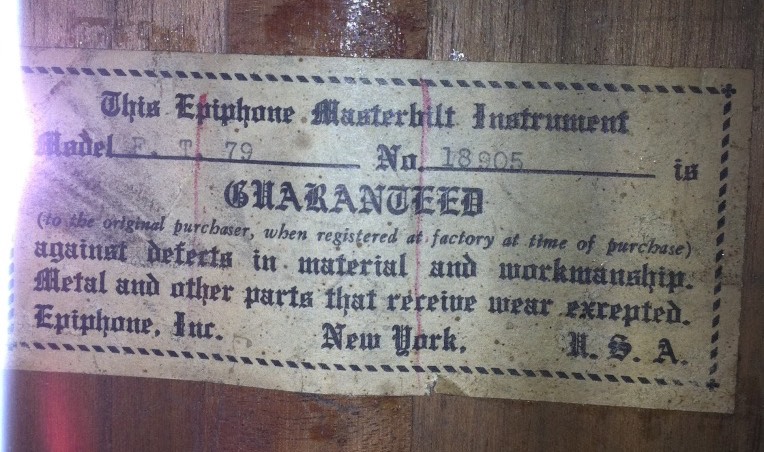
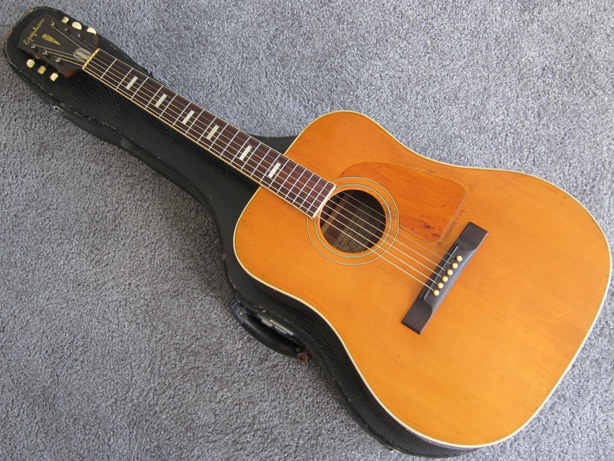
Example 3b: "Masterbilt" label with typed SN of 1940 – glued on
top of original green label
Olympic
Plectrum SN 16243 shows a pretty wild label situation which we
have only seen once so far: An older style "Masterbilt" label with
typed SN has been glued on top of the original "green" label
(which was standard for 1940)!

We would love to know the story behind this... Unfortunately, we don't know what is written on the covered-up "green" label, but we guess it had the SN 16243 printed. It would be quite interesting to know what model name is under there ... Another odd detail: Note that the long "plectrum" neck of this Olympic is actually from a Zenith model...!
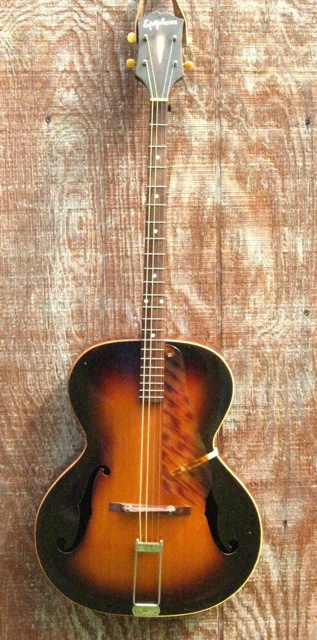
4. Mistakes,
typos, and other oddities
Example 4a: Two Labels with identical SN
So far we only know of two cases where the same SN appears on the labels of two different Epiphone instruments. Obviously mistakes – and not surprisingly these happened on labels with manually typed numbers.
One of the cases are Zenith SN 60028 and Zenith SN 60028 (a): The pics below show the two labels with the same SN – note the slightly different placement of the typed model and number.
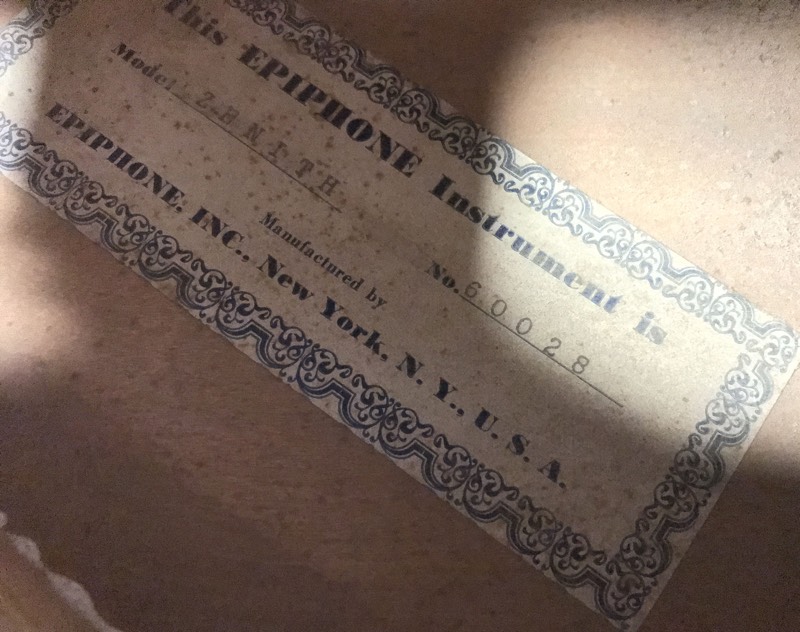

Example 4b: Label with oddly mistyped model name
A rather bizarre case is Century Spanish SN 63797: The "blue" label has the standard pre-printed SN – but the model name is spelled "CNEUTYR" instead of "CENTURY"! We have seen a few small typos on Epiphone labels, but this misspelling is rather "unbelievable"...
One wonders how this crazy typo happened and also slipped through quality control. Well, a possible answer could be related to the period in Epiphone's history when this guitar was produced: 1951 was a very difficult year for the company: A conflict with unionizing employees escalated to a strike in the NY factory which shut down production for 4 months and eventually led to a relocation of the factory to Philadelphia in spring 1952 – which prompted several employees to leave the company. We imagine that some workers must have been quite unhappy with the situation at the time. So maybe some employees expressed their frustration when working on labels at the typewriter...!? We will probably never know.

Example 4c: "Oval" Label with SN of a truncated "Masterbilt" label
Another pretty unique case we have only seen once so far. DeLuxe SN 10760 looks quite different from other 1936 examples of this model: It features an older style 16" body with rope binding and volute neck. Possibly a "special" made in 1936 from old left-over parts? Inside the body we see an "oval" label as it was used until 1934 – plus a fragment of a "Masterbilt" label with just the pre-printed SN...!
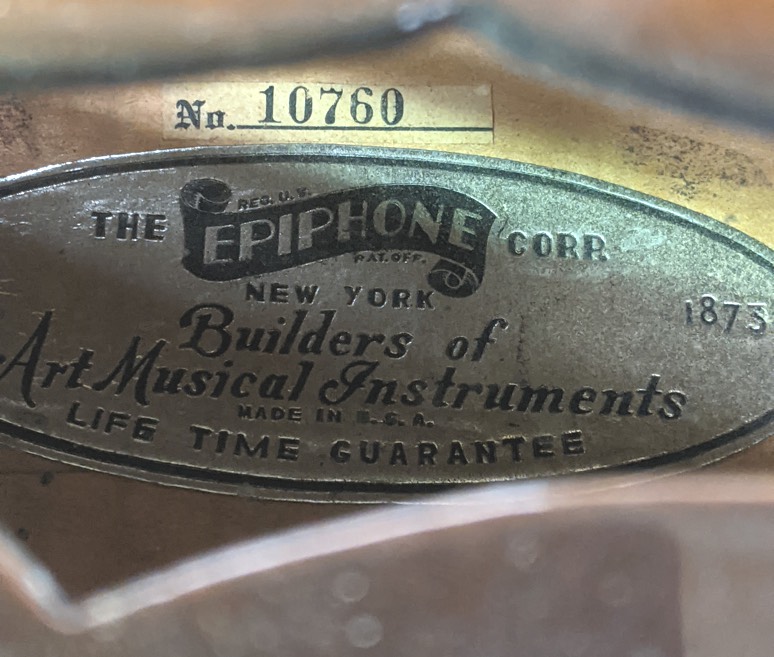

Example 4d: SN stamped on headstock of acoustic instrument
While the original NY-based Epiphone company stamped the SN on the headstock of all their electric instruments from 1935 to 1949, they never stamped the SN on the headstock of acoustic instruments. But: Several such examples have surfaced – so what's the story there?
DeLuxe SN 15352 is one of these examples: When we look at the pearl logo and inlay in the headstock veneer, it is pretty obvious that this neck was not made in 1939 – it is actually in the style of the post-1957 Epiphone instruments built in Kalamazoo after the takeover by Gibson/CMI. We assume this guitar went back to Gibson/Epiphone, Kalamazoo, in the 1960s in need of repair where it received a replacement neck – with the original 1937 SN stamped on the headstock. We have seen such stamped numbers on other NY Epiphone instruments that show signs of repair/refurbishment in the '60s Kalamazoo factory.
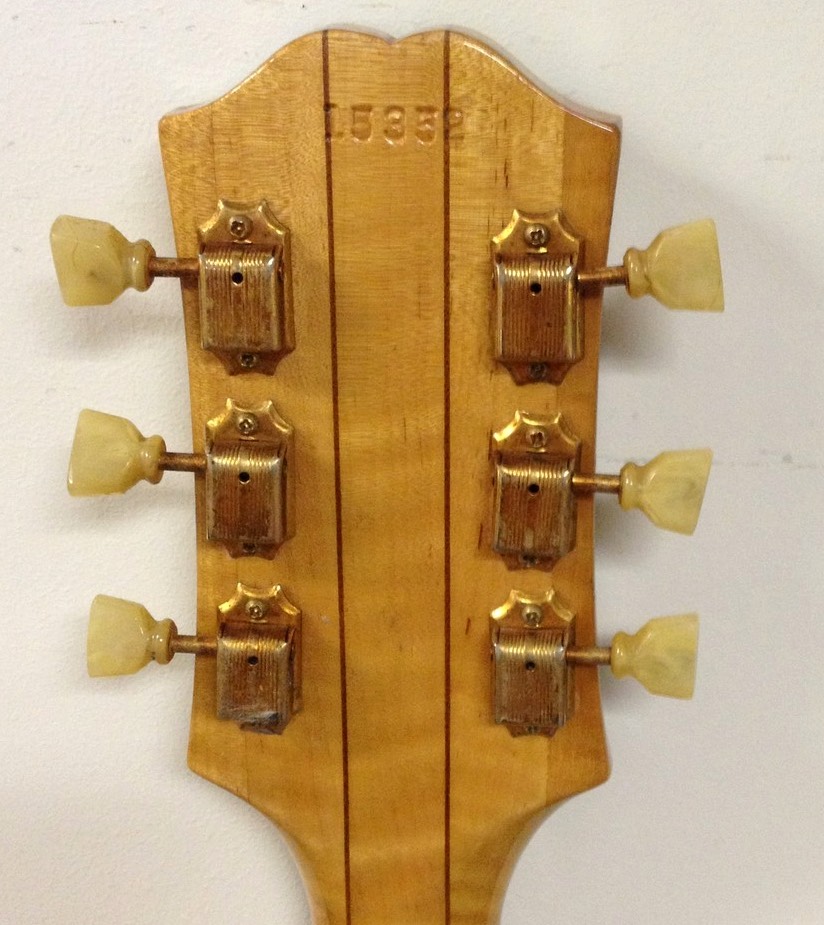

Interestingly, the fretboard on this DeLuxe features the pointy end commonly seen on a Gibson L-5...!
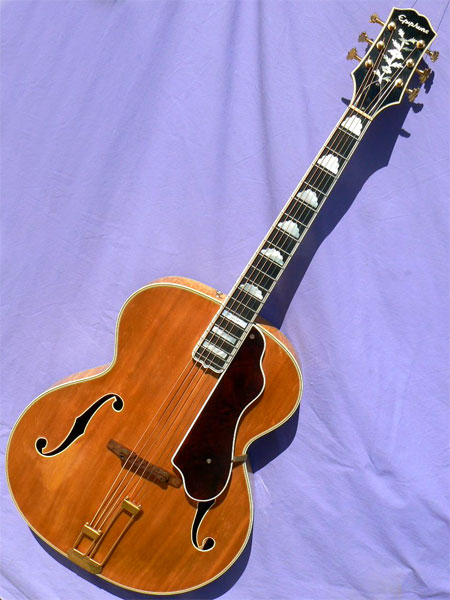
Inside the body there is still the original "Masterbilt" label with pre-printed SN.
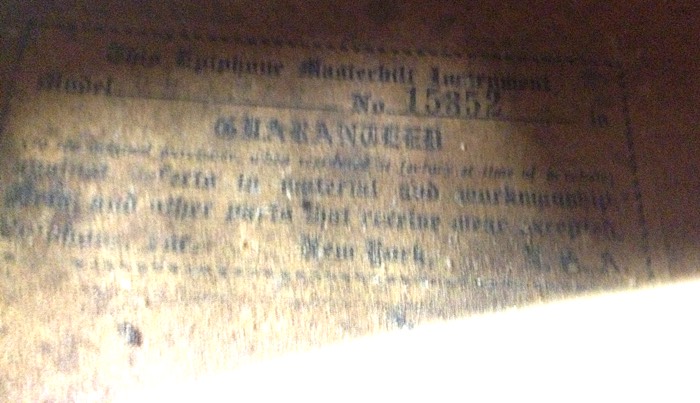
Conclusion
As mentioned, our explanations of the described
"odd" phenomena around Epiphone's labels and serial numbers are
somewhat speculative and not really backed by "hard" facts. If you can
think of other scenarios and theories, we are interested to hear and
open to discuss! Contact
us here.
Note: This overview is subject to updates whenever
new evidence surfaces.
(July 12, 2022)